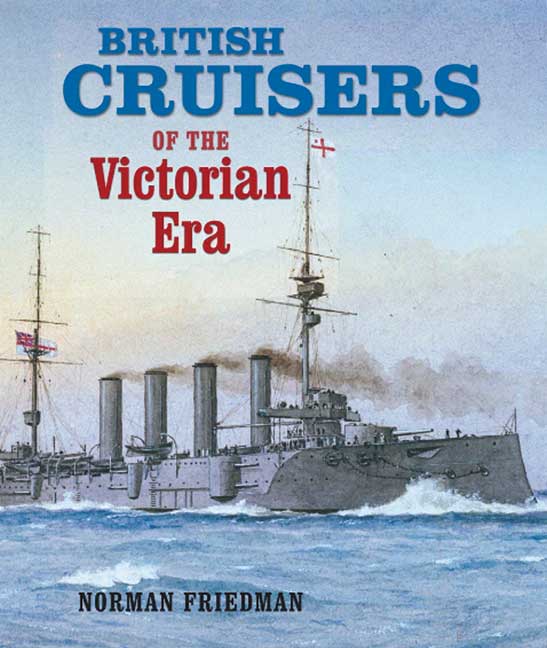
British Cruisers of the Victorian Era. By Norman Friedman. Seaforth, Barnsley, re-released 2017.
Reviewed by Tim Coyle
THIS magnificent book reinforces Norman Friedman’s unparalleled reputation as a peerless author of maritime topics. The challenge in reviewing his books is to avoid well-worn clichés such as seminal, magisterial and definitive; ‘British Cruisers of the Victorian Era’ is all this and more.
Friedman’s level of analysis is extraordinary. Not only is the text exhaustive in its technical and operational detail, the illustrations are accompanied by equally comprehensive captions. Thirty-six pages of notes offer even more information. ‘British Cruisers of the Victorian Era’ is truly a work which not only breaks ground on this hitherto sparsely addressed topic but must be the standard work of this period of warship design well into the future.
In addition to the formidable level of detailed text are the magnificent contemporary photographs and the extraordinary ship plans by A D Baker III whose art is a consistent feature of Friedman’s books.
‘British Cruisers of the Victorian Era’ begins with a 50 page Introduction discussing the changing strategic environment post the defeat of Napoleon in 1815. The topics cover trade protection, naval presence in the burgeoning British Empire of the mid-19th century and the cruiser’s role in the Royal Navy fleet. Of particular interest are the details of fleet operation and exercises from 1884 to 1898 in which fleet commanders opine on tactical problems of the day, particularly as it concerned blockade of enemy ports, the move from close blockade under sail to more distant blockade under steam and attendant communications issues before the advent of radio. After the Introduction’s overview of changing technology the narrative moves to the chronology of cruiser development starting with the paddle-wheel warships, which entered service in the early 1830s, and moves through the screw-driven steam frigates and corvettes of the 1840s and 50s. All the chapters discuss the various class programs, their design, motive power, armament and armour.
As the early frigates and corvettes morphed into cruisers ship design evolved to iron hulls, the emergence of armoured cruisers and on to fast steel cruisers and big cruisers for commerce protection. By the last quarter of the 19th century the appellation ‘cruiser’ ranged from the large commerce protectors to torpedo cruisers and smaller ships more suited to colonial presence far from the centres of naval and government authority. The culmination of the Victorian cruiser era was the ‘fast wing of the battle fleet’. In 1897 the Director of Naval Construction, W H White, advocated the construction of armoured fast cruisers ‘capable of taking part in fleet actions as adjuncts to battleships’. These initially took the form of the ill-fated CRESSEY class three of which, HM Ships CRESSY, HOGUE and ABOUKIR, were sunk by the German submarine U.9 on 21 September 1914; already obsolete these ships had been relegated to distant blockade patrols and were vulnerable to the then little-understood submarine threat. HM Ships MONMOUTH and GOOD HOPE succumbed at the unequal and vainglorious Battle of Coronel. Some of these ships were adapted as minelayers and provided valuable fleet supplementation in accordance with their design philosophy when not exposed to superior forces.
Friedman concludes this monumental study with Fisher’s Revolution in which the brilliant and tempestuous First Sea Lord, Sir John Fisher, upended the Royal Navy with his personnel and materiel initiatives which divided the service into those in the ‘Fishpond’ and those outside seeking to undermine him. Fisher considered that many of the late 19th century cruisers were an intolerable drain on the service’s resources as they could neither ‘fight nor run away’. His solution was the battle cruiser which could run with the battle fleet as full participants. The book takes the story of the last of the Victorian era cruisers into and through World War One, ending with HMS VINDICTIVE crew’s brave assault on Zeebrugge in April 1918.
British Cruisers of the Victorian Era contains a treasure trove of photographs, largely full page with some across double pages. Australian readers are rewarded by numerous illustrations – from the State Library of Victoria’s Allan C Green collection – of RN cruisers on the Australia Station. Examples are the 1867 photograph of HM Ships ARIADNE and CHALLENGER in Sydney Harbour, NELSON and RAVEN in Sydney during the 1880s and a wonderfully peaceful double page 1904 scene of HMS ROYAL ARTHUR lying in the Derwent River with booms out and boats in the water and a whaler, crewed by ratings in summer uniforms ready to ‘give way together’ with Tasmania’s Government House in the otherwise building-free hinterland. As many of the photographs are taken in port with ships at rest we see the ships’ companies about their duties. Sailors of HMS VINDICTIVE, in happier times, are captured in a beautiful starboard quarter view as they perceive the photographer’s presence. Six of them stand on the quarterdeck with a further four standing in a whaler in the davits.
This superb book examines a period of Royal Navy ship design and operations which up till now has been under reported. It comes with the highest recommendation.



